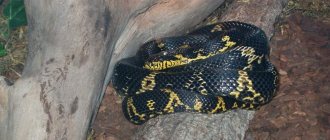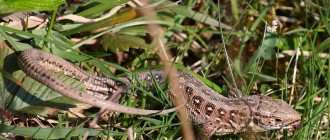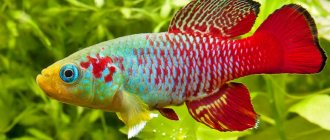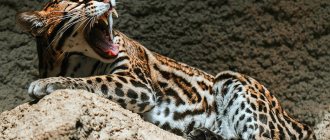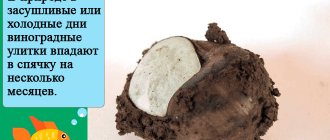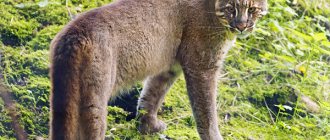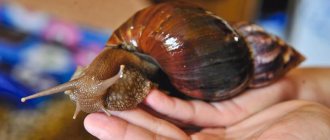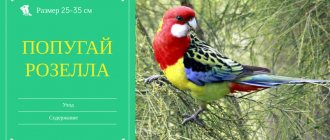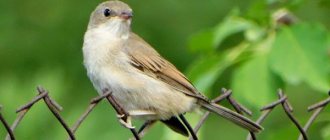- Wild animals
- >>
- Reptiles
The rainbow boa is an exotic reptile that has become a favorite of many terrarium enthusiasts. In all its rainbow and brilliant beauty, this snake-like person can appear, fanned by the rays of the bright sun. At such a moment, the boa constrictor looks truly fascinating. Let's look at his life in more detail, describing not only his external features, but also his characteristic habits, character and snake-like disposition.
Origin of the species and description
Photo: Rainbow boa
The rainbow boa has another name - aboma, this reptile is not poisonous, belongs to the family of pseudopods and the genus of smooth-lipped boas. The family is called pseudopods because. its representatives have preserved rudiments of both the hind limbs and the pelvis. Outwardly, they resemble claws.
Interesting fact: The closest relative of the rainbow boa is the anaconda, which amazes with its gigantic dimensions.
Among the smooth-lipped rainbow boas, there are several species of reptiles; the smooth-lipped genus is represented by:
- Colombian rainbow boas;
- Cuban boa constrictor;
- Ford Rainbow Boa;
- Jamaican rainbow boa;
- South American rainbow boa;
- Haitian slender boa constrictor;
- Peruvian rainbow boa.
All of the above boas are distinguished by their characteristic external features. Young Colombian boas have a wide brown stripe on the ridge, which is decorated with large spots of beige tones. Mature specimens are brown or reddish-brown and display a rich, iridescent glow in the sun.
Interesting fact: Among the South American rainbow boas, there are eight different subspecies, the color of which is very diverse, so it is very difficult to describe this species as a whole.
Peruvian rainbow boas have a clear resemblance to Brazilian boas, differing only in the number of scales and the ring-shaped pattern on the dorsal part. Cuban rainbow boas have a clearly visible contrasting pattern, which is either chocolate or black. Haitian rainbow boas are distinguished by an overall light beige background, on which black, grayish or chocolate spots can be seen, located very chaotically.
Video: Rainbow Boa
Why is the boa constrictor nicknamed rainbow, if the general tone of many reptiles varies from light beige to dark chocolate? The thing is that this snake-like person is incredibly transformed as soon as the bright rays of the sun hit her. The boa constrictor begins to shimmer like a hologram, shining with all the colors of the rainbow and bewitching those around him.
Striated kingsnake
This representative of reptiles is not poisonous, but it is very easy to confuse it with a poisonous snake with a similar bright color - the coral adder.
The king snake feeds on lizards, which it hunts mainly at night.
Lives in North America. Today, scientists know of 25 species of king snakes.
11
Appearance and features
Photo: Rainbow boa snake
Although different species of rainbow boas are endowed with their own distinctive features, they also have common characteristics that are characteristic of the genus and family. The length of these continental reptiles reaches up to two meters. One and a half meter long rainbow snakes are more common. The mass of the reptile ranges from seven hundred grams to two kilograms. The main difference between this boa constrictor is the presence of large and uniform scales in the area between the snake's eyes.
The rainbow boa constrictor can rightfully be called a real handsome man. He is listed among the ten most attractive snakes on the globe.
The predominant skin tone of a reptile may be:
- brown;
- fawn;
- brownish-red.
The ridge is decorated with large spots of lighter shades, which are bordered by a contrasting black outline, creating the effect of rings. On the sides there are smaller spots, endowed with a prominent light stripe. The center of the side spots is black; from a distance they look like eyes with a dark pupil. Closer to the belly you can see small black spots. The abdominal part itself is light in color.
As already mentioned, aboma shines and shines in the sun, enchanting with its rainbow tints. The boa constrictor's scales are smooth, without ribbing and pleasant to the touch. Snake scales, like prisms, reflect the sun's rays, sparkling with bluish, greenish, violet, red and blue highlights. Rarely, there are individuals that do not have a characteristic pattern, but they shimmer in the sun just as beautifully and temptingly.
Interesting fact: When a rainbow boa molts, its shed skin becomes colorless and has no characteristic pattern.
California garter snake
The California garter snake is a member of the subspecies of garter snakes. It is not at all dangerous and is very popular among experienced collectors and beginners.
The color of this type of snake is very diverse and each Californian snake is beautiful in its own way, and of course, it’s up to you to choose which one is more beautiful.
6
Where does the rainbow boa live?
Photo: Rainbow boa in Brazil
Rainbow boas have spread widely throughout both Central and South America. Boas inhabit tropical, humid, forest areas, and basins of large rivers (Orinoco, Amazon). They prefer to settle in places close to water sources. Almost all varieties of rainbow boa are very widespread in the wild. The distribution area depends on one or another subspecies.
The Colombian rainbow boa has chosen Panama, the north of the South American continent and Costa Rica. It is found in small quantities on the islands of Trinidad and Tobago, Margarita, and in the coastal zone of Guiana. This species prefers dry forest areas located next to savannas.
It is not difficult to guess that the South American aboma has registered and spread widely throughout South America. This boa constrictor lives both in humid areas of the tropics and in savannas and forests with a dry climate. The Paraguayan boa constrictor can be found not only in the vastness of Paraguay, but also in the wetlands of Argentina and Brazil. The Argentine species of boas has spread throughout the territories of Argentina, Bolivia and lives in the foothills of the Andes.
Nine subspecies of Aboma live in India. Most reptiles have been spotted in the Bahamas and Haiti. The Cuban species of rainbow boa is registered in Cuba. Boas have also chosen Jamaica, Puerto Rico and the Virgin and Antilles Islands.
Aboma can live in territories with completely different landscapes, inhabited by:
- in tropical forests;
- on dunes overgrown with dense bushes;
- in wetlands;
- open mountain prairies;
- savannahs;
- semi-desert areas.
The diverse habitats of reptiles indicate that rainbow boas are ecologically very plastic and can adapt to different surrounding areas.
Now you know where the rainbow boa constrictor (aboma) lives. Let's see what he eats.
White Texas Snake
This white, seemingly harmless snake, is not like that at all. Although it is not poisonous, its bites are quite painful.
It is also called the rat snake, not only because of its diet, but also because of its similarity. The snake's head is flattened and resembles a mouse's muzzle.
The Texas snake is also one of the few species of snakes with a white coloration, which makes it a favorite of terrarium keepers.
9
What does a rainbow boa eat?
Photo: Rainbow boa from the Red Book
For the most part, the menu of rainbow boas consists of all kinds of rodents and not very large birds. Different species also have special characteristic snacks. Cuban boas supplement their diet with bats and iguanas, and sometimes eat other snakes. This species prefers to hunt from ambush, patiently waiting for potential prey. Ford boas spend a lot of time in the canopy of trees and their menu is dominated by lizards.
It’s no secret that the older and larger the boa constrictor, the larger the dishes on its menu. As is typical of all boa constrictors, the rainbow one grabs its prey with its teeth, and then applies a choke hold, wrapping its muscular body around it. During a meal, especially when the prey is very large, it seems that the boa constrictor itself pulls itself onto its victim, gradually swallowing it. Metabolism in boas is slow, so digestion can take more than one day, but more often a whole week or even two.
Rainbow boas living in terrariums are also fed rodents and poultry. Little boas are treated to newly born mice. The frequency of feeding depends on the age of the reptile and its personal characteristics. Juveniles and pregnant females are fed more often (once every five days), while other mature boas can be fed less often. It is imperative that the boa constrictor always has access to clean drinking water.
Content
When choosing a terrarium, you should learn about the lifestyle of your exotic pet. If it is a semi-woody type, a vertical terrarium with high and strong walls is suitable; if it is a terrestrial type, a horizontal terrarium is preferable. The parameters of the future home must correspond to the dimensions of the snake. Whatever terrarium you choose, do not forget about ventilation: stagnant air can cause diseases in the reptile.
Since snakes like to burrow, a thick layer of hygroscopic soil will be required. For moisture-loving reptiles, moss, coconut shavings and tree bark are ideal. Be sure to install a spacious drinking bowl into which the snake can completely fit. The water is changed 2-3 times a week, and if excrement or food remains appear, immediately.
Reptiles are so designed that they need a little shelter. Its absence causes stress in the animal. For this, you can use a regular cardboard box, a flower pot, or purchase it at a pet store. During general cleaning of the terrarium, do not forget to wash it and treat it with a disinfectant, and replace the cardboard box with a new one.
The temperature regime is important for the life of the pet and is maintained using a thermal mat or thermal cord. Also, for heating terrariums with adult individuals, it is recommended to use ceramic heaters, which are selected depending on the size of the terrarium. For reliable operation of the heating system, a thermostat is installed. If lamps are used for these purposes, they must be insulated to avoid snake burns. The background temperature in the terrarium should be +26-28 0С, at the heating point – +30-32 0С, at night it is reduced to +20-22 0С.
Recommended humidity level is 75-80%. If a boa constrictor is kept in conditions of low humidity (less than 50%) for a long time, dehydration may occur, so it is better to monitor its level using a hygrometer.
Light mode is one of the components of proper snake maintenance. It affects not only the activity, but also the health of the pet. Daylight must be at least 12 hours and is provided by fluorescent lamps of various wattages.
Features of character and lifestyle
Photo: Rainbow boa
The rainbow boa prefers to live alone, moving mainly on the earth's surface. This is what mature snakes do, while young animals lead a semi-arboreal lifestyle, spending a lot of time in the crown of trees, resting on thick branches. The rainbow boa constrictor escapes from the unbearable heat by burrowing into rotting damp foliage or soil, thus cooling itself.
Aboma is an excellent swimmer; it is not for nothing that it settles close to water spaces, because mature specimens are not averse to splashing around in the refreshing water. The reptile's vision is as sharp as that of an eagle and its sense of smell is also excellent. The boa constrictor also has a very necessary device - its forked tongue, with which the snake, like a scanner, examines the surrounding space, detecting both prey and ill-wishers. Rainbow boas begin to be active at dusk, preferring to hunt at night.
If we talk about the character and disposition of these reptiles, terrariumists note that they are quite peaceful and are not particularly aggressive towards humans. Of course, if we think purely theoretically, then a boa constrictor can strangle a person, but such cases are literally rare. In order for a boa constrictor to perform a chokehold that is lethal to a person, it needs to be pretty scared or damn angry.
Because of their beautiful coloring and iridescence in the light, abomas have become very popular among snake lovers, so they are increasingly becoming pets, and it is not very difficult to keep them, because they are calm and unpretentious. In the wild, a boa constrictor, seeing a biped, tries to quickly retreat so that an unwanted meeting does not take place.
Ceylon keffiyeh
Photo: Gihan Jayaweera/Wikimedia Commons
Sri Lankan venomous snake that does not grow more than 75 cm in length. A striking feature of her appearance is her flat, triangular head with a sharp muzzle, which is connected to the body by a disproportionately narrow neck. Because of this transition, the snake resembles a spear. The color is predominantly green, with multiple black spots and lines along the back and on the head. The belly is usually gray-bluish or yellow-green. Keffiyeh is found in rain forests, meadows and plantations. Leads a predominantly nocturnal lifestyle. It feeds on lizards, frogs and mouse-like rodents.
Social structure and reproduction
Photo: Rainbow boa in Brazil
The rainbow boa cannot be called a collective reptile; it prefers to exist alone until the time of wedding season comes. During this period, the female signals her readiness for intercourse by secreting a special odorous secretion. The gentleman, sensing this alluring aroma, rushes in search of her. It also happens that several suitors apply for one woman at once. In such a situation, a fight between competitors is inevitable. They begin to collide, intertwine and even bite. The winner gets the right to own the female, and the defeated opponent is removed.
The female snake remains in position for about five months. She does not lay eggs, because... Rainbow boas are viviparous reptiles. Usually, from eight to fifteen baby snakes are born, the length of which can reach half a meter, but more often they have a length of about 25 or 30 cm, and their weight rarely exceeds 20 grams. The process of the first molt begins 10-15 days after birth. After it ends, the young snakes begin their active hunting and development. Rainbow reptiles grow throughout their entire snake life, so they molt often - about three or four times annually.
In captivity, aboma also actively and successfully reproduce, both in zoos and in private terrariums. In favorable conditions, the young quickly become stronger and grow, reaching a meter in length by the age of one year. The life span measured by nature for rainbow boas ranges from a dozen to two decades. In artificial conditions, snakes live longer than in the wild.
Honduran milk snake
This bright representative of the snake family has a very bright and compatible color in red and black tones. The combination of these two colors gives the resident of Honduras and Nicaragua a certain elegance and at the same time aggressiveness.
Although the snake is not poisonous, it is often confused with the venomous adder, which is very similar in color.
14
Natural enemies of rainbow boas
Photo: Rainbow boa snake
Although the rainbow boa constrictor is quite large, it has many enemies in natural conditions. The reptile is not poisonous, so its vulnerability increases.
An adult rainbow boa can be a snack:
- jaguars;
- wild boars;
- caymans;
- large feathered predators.
Inexperienced young animals and recently born baby snakes often suffer from common hedgehogs, coyotes, and monitor lizards. The threat to boas comes from jackals, large ravens, kites, and adult mongooses.
The enemy of the boa constrictor can also be called a person, who often invades the places of permanent deployment of reptiles, displacing them from inhabited territories. People catch aboma for further resale to terrarium keepers. In some countries, boas are considered a real delicacy, so snakes are often killed for gastronomic purposes.
For self-defense, boas have some of their own techniques and features. A frightened or angry boa constrictor will hiss loudly and may bite. Cuban rainbow reptiles curl into a ball in defense. Their eyes turn red and drops of blood appear from their mouths. This type of boa constrictor, Enygrus asper, looks like a dangerous viper and can jump perfectly. In the fight for their own life, all methods are good, which is why some boas use various tricks.
Horned viper
This horned beauty lives in the deserts of North Africa, and at first glance, does not seem aggressive. But in fact, it is very dangerous, but not insidious like some snakes.
She never waits and attacks a person first only for the purpose of self-defense. Her scales are very similar to sharp spines, but they are needed for the necessary secrecy, which she copes with perfectly.
During the day, the horned viper buries itself in the warm sand and sleeps. By the way, she has the right color for this. Therefore, when going to the African desert, watch your step very carefully.
7
Population and species status
Photo: Rainbow boa, or aboma
Although rainbow boas have spread widely throughout Central and South America, many negative factors affect their livelihoods, which leads to a gradual decline in the population; some species are very rare and difficult to find.
First of all, rapid human activity negatively affects the standard of living of the abom. Deforestation, drainage of wetlands, plowing of land for agricultural purposes, construction of human settlements and highways reduce the number of rainbow boas, disrupting their rhythm of life and displacing them from their usual habitable places.
In addition to all the above factors, boa constrictors suffer due to their popularity among terrarium keepers. They are often caught in order to later be sold privately. In some countries, aboma is consumed as food, which also has a negative impact on the population. Apparently, the number of rainbow boas has not yet reached a critical level due to the fact that they are unpretentious and reproduce well in zoos, various nature reserves and private terrariums, which is good news. However, we should not forget that some species have become very rare and may completely disappear.
Rough tree viper
When you look at this cute creature of unusual beauty, you get the impression that this is a mythical character from a fairy tale.
But not everything is as simple as it seems at first glance. A meeting between a tree viper and a person promises mortal danger for the latter, so do not play with fire.
5
Green python
A large non-venomous snake of the pseudopod family. Characterized by a calm, non-aggressive disposition. The body length of adult individuals can reach 2 m. Interestingly, snakes are born yellow or red, and only after a year their color changes to green. For this reason, when young, pythons live on the outskirts of tropical forests in order to better camouflage themselves with their surroundings. And when they grow up, they move into the forest thicket to be invisible among the dense tree foliage. You can meet unusual pythons in Papua New Guinea or on the Cape York Peninsula in Australia.
